

Origin of AIDS: The Polio Vaccine (CBC 'Witness', 2004) Health Book Review: The River: A Journey to the Source of HIV and AIDS by Edward Hooper, Bill Ham... Les origines du SIDA (2004) Edward Hooper's site on the Origin of AIDS. Welcome to the new AIDS Origins site: July 4th, 2013.
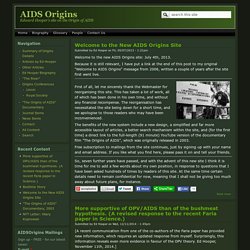
Because it is still relevant, I have put a link at the end of this post to my original "Welcome to AIDS Origins" message from 2006, written a couple of years after the site first went live. First of all, let me sincerely thank the Webmaster for reorganising this site. This has taken a lot of work, all of which has been done in his own time, and without any financial recompense. The reorganisation has necessitated the site being down for a short time, and we apologise to those readers who may have been inconvenienced. The benefits of the new system include a new design, a simplified and far more accessible layout of articles, a better search mechanism within the site, and (for the first time) a direct link to the full-length (91 minute) YouTube version of the documentary film "The Origins of AIDS", which was originally released in 2003.
Where does the pathological misfolding of the prion originate? Mother to Offspring Transmission of Transmissible Spongiform Encephalopathy TSE prion disease. Mother to Offspring Transmission of Chronic Wasting Disease in Reeves’ Muntjac Deer Amy V.
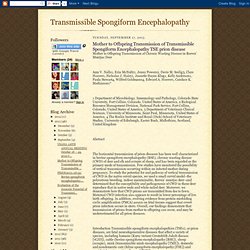
Mad Cow-Like Brain Illness Found In British Family: The Mystery Of Prions. A British family has been found to suffer from a deadly brain illness, similar to mad cow disease, which has already been passed down through several generations without external transmission, a new study reports.
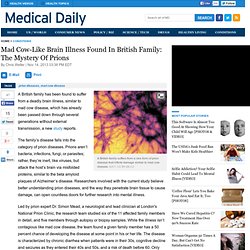
The family’s disease falls into the category of prion diseases. Prions aren’t bacteria, infections, fungi, or parasites; rather, they’re inert, like viruses, but attack the host’s brain via misfolded proteins, similar to the beta amyloid plaques of Alzheimer’s disease. Researchers involved with the current study believe better understanding prion diseases, and the way they penetrate brain tissue to cause damage, can open countless doors for further research into mental illness. Led by prion expert Dr. Simon Mead, a neurologist and lead clinician at London's National Prion Clinic, the research team studied six of the 11 affected family members in detail, and five members through autopsy or biopsy samples.
Deadly Brain Illness Discovered in British Family. Randy Dotinga HealthDay Reporter Posted: Wednesday, November 13, 2013, 5:00 PM WEDNESDAY, Nov. 13 (HealthDay News) -- A British family harbors a deadly inherited illness that destroys the brain in a way that is similar to the dreaded mad cow disease, researchers report.

The newly discovered condition doesn't appear to be contagious, unlike mad cow disease. As a result, it seems to pose no threat to people who aren't part of the family. But researchers believe members of the family face a 50 percent likelihood that they'll develop the disease in mid-life and die. "It has been passed on from generation to generation," said study author Dr. Mad cow disease: One in 2,000 people in UK carry 'abnormal proteins' linked to vCJD. The abnormal proteins are linked to variant Creutzfeldt-Jakob disease (vCJD) - the human form of mad cow diseaseThe BMJ study has 'important implications' for how blood and blood donations are managed and for the handling of surgical instrumentsBut despite the higher number of carriers, just 177 vCJD cases have been reported to date in the UK By Anna Hodgekiss and Jenny Hope Published: 16:15 GMT, 15 October 2013 | Updated: 00:18 GMT, 16 October 2013 One in 2,000 people in the UK carries abnormal proteins linked to variant Creutzfeldt-Jakob disease (vCJD) - the human form of mad cow disease.

Discovery may explain how prion diseases spread between different types of animals - Faculty of Medicine & Dentistry - University of Alberta. Valerie Sim leads the research team that discovered a miniscule change in prions’ makeup that appears to give the disease the ability to adapt.
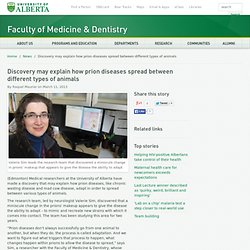
(Edmonton) Medical researchers at the University of Alberta have made a discovery that may explain how prion diseases, like chronic wasting disease and mad cow disease, adapt in order to spread between various types of animals. The research team, led by neurologist Valerie Sim, discovered that a miniscule change in the prions’ makeup appears to give the disease the ability to adapt – to mimic and recreate new strains with which it comes into contact. The team has been studying this area for two years. “Prion diseases don’t always successfully go from one animal to another, but when they do, the process is called adaptation. “We want to determine why one prion disease might be able to spread from one type of animal to another and why another strain of the disease can’t.”
Study Could Shed Light on Prion Adaptation. News Study Could Shed Light on Prion Adaptation 13 March 2013 CANADA – A University of Alberta research team has made a discovery that could explain how prion diseases adapt in order to spread across different species.
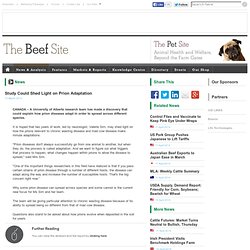
It is hoped that two years of work, led by neurologist, Valerie Sim, may shed light on how the prions relevant to chronic wasting disease and mad cow disease make minute adaptations. "Prion diseases don't always successfully go from one animal to another, but when they do, the process is called adaptation. Discovery may explain how prion diseases spread between different types of animals. Medical researchers at the University of Alberta have made a discovery that may explain how prion diseases, like chronic wasting disease and mad cow disease, adapt in order to spread between various types of animals.
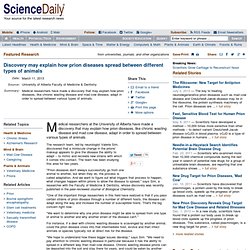
The research team, led by neurologist Valerie Sim, discovered that a miniscule change in the prions' makeup appears to give the disease the ability to adapt -- to mimic and recreate new strains with which it comes into contact. The team has been studying this area for two years. "Prion diseases don't always successfully go from one animal to another, but when they do, the process is called adaptation. And we want to figure out what triggers that process to happen, what changes happen within prions to allow the disease to spread," says Sim, a researcher with the Faculty of Medicine & Dentistry, whose discovery was recently published in the peer-reviewed Journal of Biological Chemistry.
Prion-like spreading of pathological α-synuclein in brain. + Author Affiliations Correspondence to: Masato Hasegawa, Ph.D.
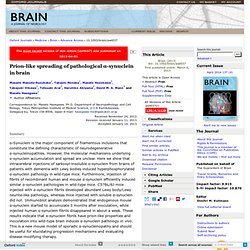
Department of Neuropathology and Cell Biology, Tokyo Metropolitan Institute of Medical Science, 2-1-6 Kamikitazawa, Setagaya-ku, Tokyo 156-8506, Japan E-mail: hasegawa-ms@igakuken.or.jp Received November 24, 2012. Revision received January 11, 2013. Accepted January 14, 2013. α-Synuclein is the major component of filamentous inclusions that constitute the defining characteristic of neurodegenerative α-synucleinopathies. Chronic wasting disease vaccine study under way - Laramie Boomerang Online. By EVE NEWMAN / even@laramieboomerang.com • Friday, March 08, 2013 A multi-year study conducted by the Wyoming Game and Fish Department aims to test the effectiveness of a new vaccine for chronic wasting disease.
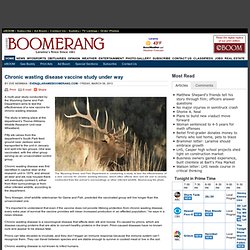
The study is taking place at the department’s Thorne-Williams Wildlife Research Unit near Wheatland. Fifty elk calves from the department’s South Park feed ground near Jackson were transported to the unit in January and split into two groups. One was vaccinated, with the other group serving as an unvaccinated control group. Proteins with mutations in 'prion-like' segments considered candidates for inherited forms of ALS. A multi-institution group of researchers has found new candidate disease proteins for neurodegenerative disorders.
James Shorter, Ph.D., assistant professor of Biochemistry and Biophysics at the Perelman School of Medicine, University of Pennsylvania, Paul Taylor, M.D., PhD, St. Jude Children's Research Hospital, and colleagues describe in an advanced online publication of Nature that mutations in prion-like segments of two RNA-binding proteins are associated with a rare inherited degeneration disorder affecting muscle, brain, motor neurons and bone (called multisystem proteinopathy) and one case of the familial form of amyotrophic lateral sclerosis (ALS). Two new genes linked to amyotrophic lateral sclerosis (ALS) and related disorders. Prion Update: More Evidence That Species Barrier A Myth. If you're new here, you may want to subscribe to my RSS feed. Thanks for visiting! Sick deer infect their environment, including soil and water. Prions migrate, mutate and multiply, which means that the species barrier is a myth.
Species-barrier phenomenon in prion transmissibility from a viewpoint of protein science. + Author Affiliations ↵* Ken'ichi Hagiwara, Department of Biochemistry and Cell Biology, National Institute of Infectious Diseases, 1-23-1 Toyama, Shinjuku-Ku, Tokyo 162-8640. Tel: 81-3-4582-2734, Fax: 81-3-5285-1157, email: hagiwark@nih.go.jp Received October 4, 2012. Accepted November 29, 2012. Transmissible spongiform encephalopathies (TSEs), or prion diseases, are fatal infectious neurodegenerative disorders.
Their causative agents are prions which are composed of disease-associated forms of prion protein (PrPSc). Advances in imaging of prion disease progression in mice and humans. Several recent advances in imaging of asymptomatic mice and humans offer the possibility that the progression of prion disease can be detected before symptoms arise. Tamguney 2009, of the Prusiner lab at UCSF, presents the first use of Tg(Gfap-Luc) mice in prion disease research. Let’s dissect that terminology: Tg = transgenic, Gfap = glial fibrillary acidic protein, luc = luciferase. These mice express a transgene of luciferase under the Gfap promoter, so that astrocytic gliosis, which occurs in response to prion infection, can be detected in the live animal via the number of photons emitted by the bioluminescent reactions that luciferase catalyzes.
Infectious Prion Digested by Crows. Kurt C. VerCauteren and colleagues, United States Department of Agriculture, Animal and Plant Health Inspection Service, Wildlife Services, National Wildlife Research Center, Colorado, USA, show in an experiment that American crows (Corvus brachyrhynchos) function as passive carriers or dispersers of infectious prions. Prions are misfolded proteins inducing the misfolding of proteins into prions in an organism. They are responsible for the transmissible spongiform encephalopathies (TSE) diseases in mammals, including bovine spongiform encephalopathy (BSE) in cattle and Creutzfeldt–Jakob disease (CJD) in humans. As avian scavengers, crows may consume tissue of animal carcasses infected with prions. Prion Remains Infectious after Passage through Digestive System of American Crows (Corvus brachyrhynchos) Could carrion birds help spread prion diseases?
Crows don't digest prions, may transport them to other locations. Usda And Animal Movement Regulations Pertaining To Tse Prion Disease - QDMA Forums. Prion disease- (proteinaceous infectious particles) Is it multiple concussion disease too? Blogging the Human Genome: Was cannibalism disturbingly common in our past?
July 2, 2012 Issue - Vol. 90 Issue 27. 'Mad cow disease' in cattle can spread widely in autonomic nervous system before detectable in the central nervous system. Prion-infected cells regulate the release of exosomes with distinct ultrastructural features. Origins of Key Immune Cells Discovered in Mice. Neuropathologists at the Univ. of Zurich have solved the puzzle surrounding the origins of follicular dendritic cells — cells of lymphoid organs that play an important role in many autoimmune and infectious diseases. The UZH research team has demonstrated that follicular dendritic cells originate in cells located in the walls of blood vessels.
Thanks to these findings, scientists now have the means to investigate key features of the development of autoimmune diseases, chronic inflammation, tumors, and prion infections. Chronic inflammatory conditions are extremely common diseases in humans and in the entire animal kingdom. Both in autoimmune diseases and pathogen-caused diseases, the inflamed areas are rapidly colonized by antibody producing B lymphocytes — which organize themselves in highly structured areas called “lymphoid follicles.”
The scaffold of such follicles is provided by follicular dendritic cells (FDCs). But where do FDCs come from? Researchers discover the origins of key immune cells. Chronic inflammatory conditions are extremely common diseases in humans and in the entire animal kingdom. Prion Protein, Pierce Chemical.
Sequence variations of the bovine prion protein ge... [J Vet Sci. Molecular Pathogenesis of Prion Diseases - Download Statistics. Newsroom : Prion busting molecules. Computational Studies of the Structural Stability of Rabbit Prion Protein Compared to Human and Mouse Prion Proteins - Download Statistics.